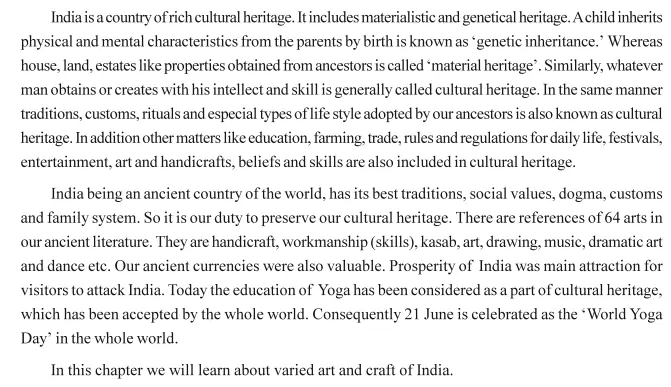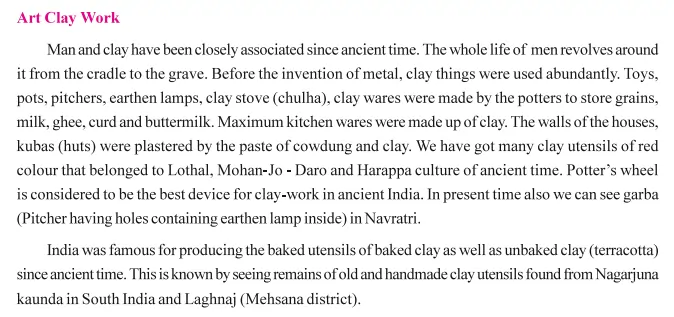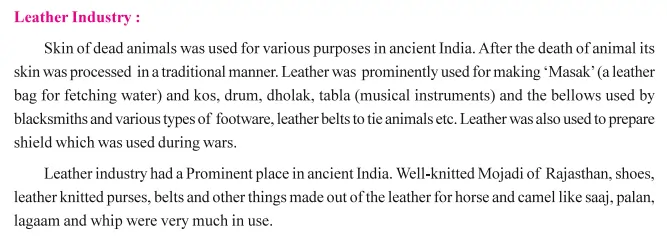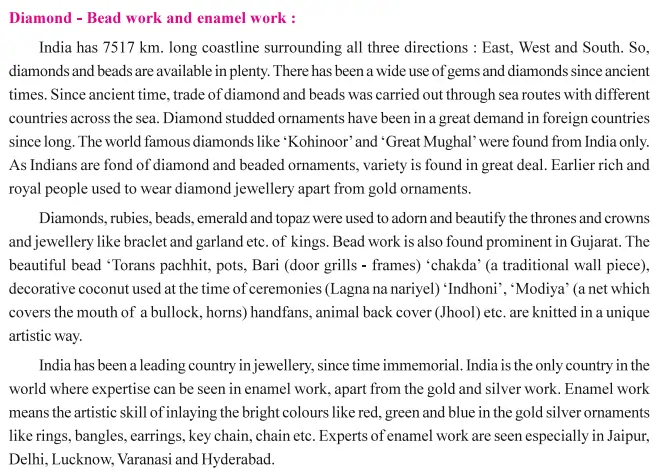Boost Your GSEB Class 10 Social Science Prep with Chapter 2: Cultural Heritage of India: Traditional Handicraft and Fine Arts Notes
Get ready for your board exams with our clear and concise revision notes for GSEB Class 10 Social Science Chapter 2. These notes summarize the key points effectively, helping you excel in your exams.
Notes have the following benefits:
- Covering all essential topics related to India’s cultural heritage, traditional handicrafts, and fine arts.
- Easy to Understand
- Structured
- Key Highlights
- Exam-Focused
Maximize your study time and perform well in your exams with our GSEB Class 10 Social Science Chapter 2 revision notes. These notes will prepare you to tackle any question effectively. Good luck with your studies!
Summary Notes For Cultural Heritage of India: Traditional Handicraft and Fine Arts
India’s rich cultural heritage encompasses materialistic and genetic aspects. Genetic inheritance refers to the transfer of physical and mental characteristics from parents by birth.
Material inheritance includes properties like land, houses, and estates passed down from ancestors. Ancient literature references 64 arts.
Traditional Handicrafts
| Traditional Handicrafts | Main Keywords |
|---|---|
| Art of Clay Work | Clay, Lothal, Mohenjodaro, Harappa |
| Art of Weaving | Textile, Muslin, Carpets, Patola |
| Art of Embroidery | Embroidery, Bandhani, ‘Jat’ community |
| Leather Industry | Leather, Drums, Footwear, Belts |
| Diamond-Bead Work and Enamel Work | Diamonds, Enamel, Jewelry |
| Jari Work | Golden, Silver Threads, Surat |
| Metal Work | Lothal, Copper, Bronze, Arms, Ammunition |
| Wooden Art | Idols, Furniture, Idar, Sankheda |
| Inlay Work | Ornaments, Bikaner, Precious Gems |
| Akik Work | Precious Stone, Chalcedonic, Rangpur, Surat |
| Painting | Indian Art, Bhimbetka, Ajanta, Ellora |
Fine Arts and Music
| Fine Arts and Music | Main Keywords |
|---|---|
| Music | Samveda, Classical Music, Ragas |
| Dance | Bharatnatyam, Kuchipudi, Kathak, Odissi, Manipuri |
| Dramatic Art | Bharatmuni, Kalidas, Jayshankar Sundari |
| Dances of Gujarat | Garba, Mali No Chaalo, Thakryo Chaalo |
Introduction Notes Cultural Heritage of India: Traditional Handicraft and Fine Arts

- India’s cultural heritage encompasses both materialistic and genetic elements.
- Material heritage includes properties like houses and land passed down through generations.
- Genetic inheritance involves the transfer of physical and mental traits from parents to offspring.
- Cultural heritage covers intellectual and creative achievements.
- It encompasses traditions, customs, rituals, and ancestral lifestyles.
- It includes various aspects like education, agriculture, trade, daily life rules, festivals, art, handicrafts, beliefs, and skills.
- India’s ancient traditions and values are a reflection of its profound cultural heritage.
- It is our responsibility to preserve this heritage.
- Ancient Indian literature mentions 64 arts, such as handicrafts, music, dance, and more, which represent a rich cultural legacy.
- India had valuable historical currencies, and its prosperity attracted visitors and invaders.
- Yoga education is now a part of India’s cultural heritage and is celebrated worldwide with “World Yoga Day” on June 21.
Arts Of Indian Artisans Notes

- The beauty of Indian cultural heritage lies in the traditional art of its artisans.
- Indian artisans skillfully create and enhance diverse lifestyles through traditional art and handicrafts.
- They excel in various forms of artistic expression, including
- weaving
- embroidery
- woodworking
- clay
- drawing
- painting
- leatherwork
- enamel
- sculpture
- architecture
- gem cutting
- and knitting.
Art Clay Work Notes

- Man and clay have a long-standing connection.
- Clay has been essential in various aspects of life.
- Before metal, clay items like toys, pots, pitchers, lamps, and kitchenware were prevalent.
- Clay was used for walls and hut construction.
- Archaeological found red clay utensils from Lothal, Mohenjo-Daro, and Harappa feature.
- The potter’s wheel was crucial for ancient Indian clay work.
- Even today, clay Garbas with embedded lamps are seen during Navratri.
- India’s historic reputation includes baked and unbaked clay utensils.
- Evidence includes old clay utensils found in Nagarjuna Konda and Laghnaj in South India.
Notes On Art Of Weaving

- Spinning: Creating long threads by joining small pieces of cotton from cotton balls.
- Gandhi’s importance in promoting it as a cottage industry and connecting it to swadeshi.
- Integral part of the freedom movement.
- Hand Weaving in India:
- Ancient textile expertise.
- Fine muslin of Dhakha, passable through a ring and fitting in a matchbox.
- Carpets, knitting work, and artistic textiles.
- Unique identities: Patola, Kanjivaram, Banarasi sarees, Bandhani.
- Patola of Patan:
- Flourished during the Solanki era in Gujarat.
- World-famous Patolas in Patan during Siddharaj Jaysingh’s reign.
- Over 850 years old art.
- Few artisans possess the skill.
- Patola of Patan, known for its durability and reversible design.
- Traditional saying: “પડી પટોળે ભાત, ફાટે પણ ફીટે નહિ'”.
Art Of Embroidery Work Notes

- Embroidery seen on clothes in Harappa and Mohenjo-Daro excavations.
- Ancient art of weaving famous for men, women, and children’s clothing.
- Embroidery in Sindh, Saurashtra, and Kutch regions during Indus civilization.
- Kashmiri (kasab) work is renowned.
- Bandhani of Jamnagar, Jetpur, Bhuj, and Mandvi in Gujarat.
- Traditional Bandhani styles with elephant, puppet, dice, and pitcher designs.
- Women from Kutch and Saurashtra regions took over cottage industry.
- Traditional embroidery on torans, chakda, pillow covers, bed sheets, shakh, todaliya, kediya clothes.
- Quilts and shawls feature various embroidery designs.
- Unique embroidery work by the Jat community in Banni area of Kutch.
Leather Industry Notes

- Ancient India utilized animal skins for various purposes.
- Skins processed traditionally.
- Leather used for Masak, kos, drums, dholak, tabla, and blacksmith’s bellows.
- Also used for footwear, leather belts, and shields in warfare.
- Prominent leather industry in ancient India.
- Well-known Mojadi in Rajasthan, leather shoes, purses, belts, and items for horses and camels.
- Items like saaj, palan, lagaam, and whips were commonly used.
Diamon-Bead and Enamel Work Notes

Beadwork in India:
- India’s has 7517 km coastline provides access to diamonds and beads.
- Beads have been used for adornment and decoration for centuries.
- Trade of beads through sea routes with other countries is a historical practice.
- Indian jewelry features a wide variety of beadwork, including ‘Torans,’ pots, door grills, wall pieces, decorative coconuts, ‘Indhoni,’ ‘Modiya,’ hand fans, and animal back covers.
- Beadwork is known for its unique artistic expression, especially in Gujarat.
Enamel Work in India:
- India has a rich tradition of jewelry-making, with a unique expertise in enamel work.
- Enamel work involves inlaying bright colors like red, green, and blue into gold and silver ornaments, including rings, bangles, earrings, key chains, and chains.
- Expert enamel artisans are found in cities like Jaipur, Delhi, Lucknow, Varanasi, and Hyderabad.
- Enamel work adds vibrant and intricate designs to jewelry, making it highly prized and distinct.
Cultural Heritage of India: Sculpture and Architecture Class 10 GSEB Notes
- Sculpture and architecture have given a unique identity to India’s cultural heritage.
- Sculpture involves shaping figures or designs with chisel and hammer, while architecture is the art of construction.
Ancient Indian Town Planning
- Ancient Indian towns were divided into three sections:
- Forts for rulers
- Houses of administrative officers on the upper part
- Residences of common people on the lower part
Indus Valley Civilization
- Harappa and Mohenjodaro had the best town planning in the Indus Valley Civilization.
- Mohenjodaro, discovered in 1922, means ‘the heap of the dead.’
- Houses were built on high plinths to protect from floods, with rich houses having multiple stories.
- Roads were wide, and the drainage system was efficient, emphasizing health and hygiene.
Harappan Civilization Discoveries
- Dholaveera, a contemporary town to Harappa, exhibited systematic town planning.
- Palaces and walls were painted white, and a proper water purification system was in place.
Stupas and Ashoka’s Contributions
- Stupa is an oval-shaped structure, and five famous stupas were built during King Ashoka’s time.
- Stone inscriptions by Ashoka in Ambaia, Meerut, and others are notable examples of stone-engraving.
- Samath, a preaching place of Buddha, features a lion-pillared structure and four lions as the national emblem.
Gupta Period Achievements
- Gupta period witnessed flourishing of architecture, sculpture, painting, dancing, and music.
- Ajanta and Ellora caves, Elephanta caves, Udaygiri, and Bagh caves are exemplary of Gupta cave architecture.
- Parvati temple, Bhumra Shiva temple, and others showcase Gupta art.
Pallava and Chola Period
- Pallava’s chariot temple, carved from a single rock, is a unique feature.
- Kailashnath temple, Vaikutha Perumal, and Mahabalipuram temples are renowned rock-cut temples.
- Gopuram, the temple entrance, gained prominence during the Pandya rulers.
Jain Temples and Medieval Architecture
- Khajuraho’s temples, especially by the Chandela rulers, are notable medieval constructions.
- Jain temples at Palitana, Delwara, and Ranakpur showcase excellent construction, carving, and sculpture.
Medieval Architecture in Gujarat
- Qutub-ud-din Aibak built Qutub Minar, Adhai-din-ka Jhopra, and Adina Mosque.
- Gujarat’s royal palaces, forts, gates, kirtistambh, inns, and other structures contribute to its architectural richness.
Important Terms
- Vastu: Sanskrit term for architecture, directly related to residence.
- Citadel: Forts of rulers in Indus Valley town planning.
- Harappan Civilization: Found first at Harappa, the remains of the Indus Valley Civilization.
- Fortification: Walls encircling a town for protection.
- Lothal: Ancient port in Gujarat between Bhogavo and Sabarmati rivers.
- Harmika: Railing around the top of an oval-shaped stupa.
- Medhi: Elevated circular path around a stupa used for pradakshina.
- Toran: Gateway with artistic horizontal beam on two high pillars.
- Pillar Inscription: Stone inscriptions carved by Emperor Ashoka’s religious order.
- Dravid Style: Semi-circular, oval, and bell-shaped architecture seen in Satavahana region.
- Trimurti: Carving of Brahma, Vishnu, and Mahesh in Elephanta caves.
- Chariot Temple: Architecture carved from a single rock, seen in Pallava age.
- Garbha Gruha: Small dark room in a temple where the idol is kept.
- Gopuram: Entrance gateway of a temple, prominent in South Indian temples.
- Taaldhwajagiri: Pilgrim site near the mouth of Shetrunji river in Bhavnagar district.

